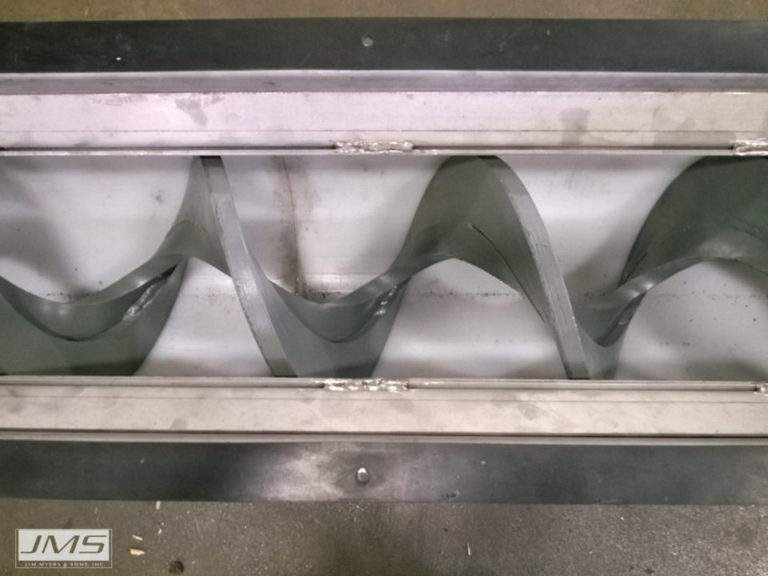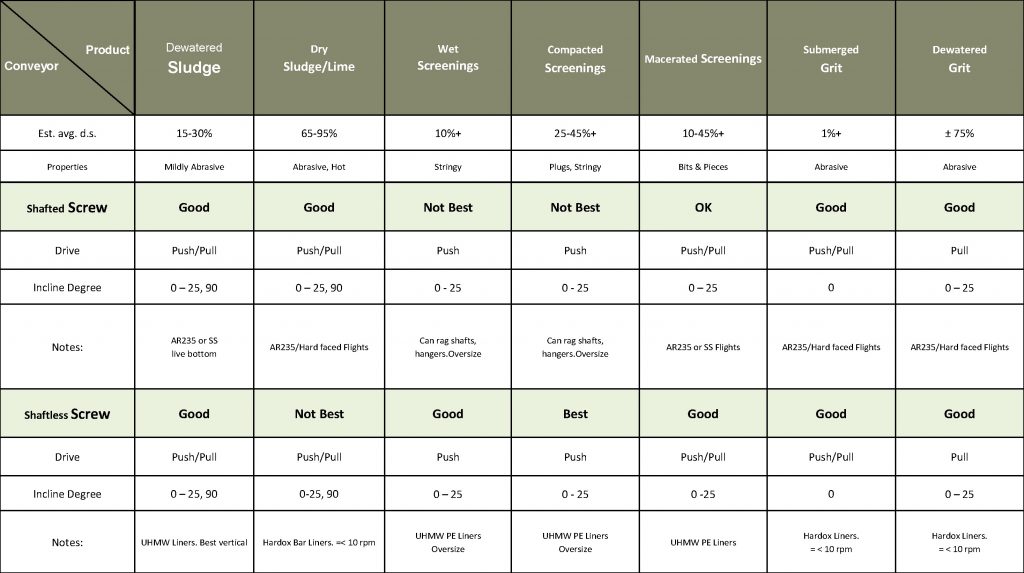Over the years, the use of screw conveyors in municipal wastewater plants has been popular for a combination of reasons. The full enclosure of the screw conveyor helps with two big housekeeping issues at the wastewater treatment plant; spilling of materials and odor control. Another reason many plants use screw conveyors is their compact design. The compact design allows for their use in tight and congested areas of the plants. In addition to this, their ability to handle a wide variety of materials also makes them a good choice.
One question that a lot of engineers and plant people ask about screw conveyors is: “when should I use a shafted screw conveyor” or “when should I use a shaftless screw conveyor”? These are great questions and the answer should be investigated for each individual operation as they assess their day to day needs.


Why use shafted screw conveyors?
A shafted screw conveyor is a screw conveyor that has a solid shaft that goes through the flighting of the screw. This helps hold the flighting off of the bottom of the trough.

Pros of a shafted screw conveyor:
- A shafted screw conveyor can be a longer length. In most applications, the shafted screw conveyor uses hanger bearings every 10-12 feet.
- A shafted screw conveyor has no need for a liner which results in less maintenance.
- A shafted screw conveyor can run at higher rpms because there is no concern about liner wear.
Cons of a shafted screw conveyor:
- The need of hanger bearings for longer conveyors. These may obstruct material flow in high capacity conveyors.
- Shafted screw conveyors have a lower fill rate due to the need for hanger bearings. The usual fill rate for a shafted screw is around 15%-30%.
- Shafted screws are not suited for stringy materials like screenings.
- Shafted screw conveyors may have a higher capital cost in certain situations with flanged shafts and flexible hanger bearings.
Why use shaftless screw conveyors?
A shaftless screw conveyor has only a spiral or helix without a center shaft. The screw then rides on a liner which is typically made from ultra-high molecular weight Polyethylene material. The only connection point in a shaftless screw conveyor is at the drive end of the screw conveyor.

Pros of a shaftless screw conveyor:
- One of the main reason to use a shaftless conveyor is the ability to handle different type of material. Shaftless screw conveyors can convey stingy, sticky, wet, and lumpy materials.
- Without the need for hanger bearings a shaftless conveyor can have a higher fill rate at closer to 35%-40%. For applications such as live bottom hoppers, and metered feed, it is possible to run a shaftless screw conveyor at 100%.
- Shaftless screw conveyors are ideal for pulling vertical conveyors since there is not a bottom shaft or seal.
Cons of a shaftless screw conveyor:
- A Shaftless conveyor is going to need the liner removed and replaced since it is a wear item. This can often be an issue if the screw conveyor is located high up or in a tight location.
- For longer runs and higher volume applications, there will be the need for reinforcements on the screw, due to the compression of the spiral under pushing load, and elongation under pulling load.
Conclusion on Shafted Screw Conveyors vs Shaftless Screw Conveyors
Screw Conveyors are a standard ”go to” in wastewater treatment plants in both shafted and shaftless forms. Both designs have their pros and cons, and the final choice typically comes down to what material the screw conveyor conveying, and owner preference. Below is a chart for quick reference to choose between a shafted and shaftless screw conveyors depending on the material being conveyed.

Greg Hyde joined the JMS Sales and Marketing Team as Product Manager | Material Handling. Greg has over 30 years of experience in material handling systems, having held high level engineering, sales and business management positions with large full line conveyor manufacturers. He is responsible for overall support and growth of the JMS Bio-HANDLING product line. Outside of work, Greg is a founding member of the “Jammin’ 4 Water” (Water Charities Fundraising Inc.). In regards to his position, Greg says, “ JMS has a rich history in design, quality and material handling. I’m excited to be part of this great team and look forward to guiding the Bio-HANDLING product family for long-term growth.”

